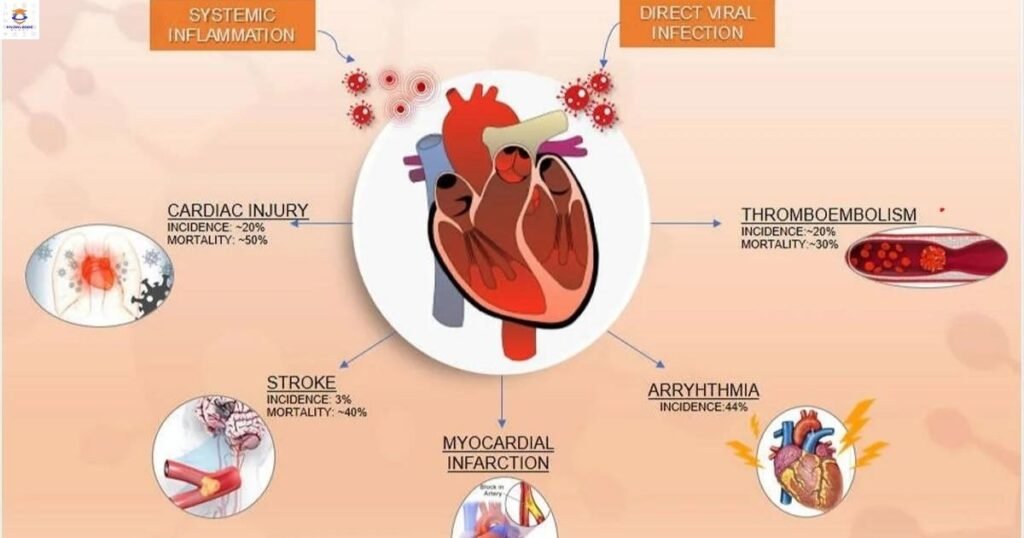Cardiovascular disease (CVD) is a class of conditions affecting the heart and blood vessels. It includes diseases like coronary artery disease, heart attacks, congestive heart failure, stroke, congenital heart defects, arrhythmias, atherosclerosis, and more.
CVD is the #1 cause of death globally, responsible for over 17 million deaths per year. Understanding CVD can help you lower your personal risk and recognize warning signs. This article provides an overview of cardiovascular disease, risk factors, prevention, and treatment options.
Read More: Human Cardiovascular System

The Basics of Cardiovascular Disease
The cardiovascular system includes the heart, blood, and blood vessels that circulate oxygen, nutrients, and blood throughout the body. CVD develops when blood flow is impaired because of blocked vessels, abnormal heart rhythms, or other dysfunction. Common diseases include:
- Coronary artery disease – buildup of plaque in the heart’s arteries
- Heart attack – blocked blood flow to the heart muscle
- Stroke – blocked blood flow to the brain
- Heart failure – inability of the heart to pump sufficiently
- Arrhythmias – abnormal heart rhythms
- Congenital heart defects – abnormalities present from birth
Cardiologists are medical doctors who specialize in diagnosing and treating CVD. They can perform procedures like stenting blocked arteries, prescribe medications, implant pacemakers, and surgically repair or replace heart valves.
Major Risk Factors for Cardiovascular Disease
Certain risk factors increase your chances of developing CVD. Risk factors you can modify include:
- High blood pressure
- High cholesterol
- Diabetes
- Smoking
- Obesity and excess weight
- Physical inactivity
- Unhealthy diet
Non-modifiable risk factors include age, sex, ethnicity, and family history. The more risk factors you have and the greater their severity, the higher your risk of CVD.
Prevention of Cardiovascular Disease
Much CVD can be prevented by living heart-healthy:
- Maintain healthy blood pressure, cholesterol and blood sugar levels
- Don’t use tobacco products
- Eat a nutritious diet high in fruits, vegetables, and whole grains
- Exercise regularly – aim for 150 minutes per week
- Achieve and maintain a healthy weight
- Limit alcohol and salt intake
- Manage stress levels
Detecting and treating risk factors early significantly reduces your risk of becoming seriously ill with CVD.

Symptoms and Diagnosis of Cardiovascular Disease
Symptoms of CVD can include:
- Chest pain, tightness, or discomfort
- Shortness of breath
- Pain in the arms, neck, back, stomach or jaw
- Feeling lightheaded or dizzy
- Nausea
- Fatigue
Diagnostic tests used to evaluate CVD include ECGs, echocardiograms, stress tests, CT scans, blood tests, angiograms, and holter monitoring. CVD can often be detected and treated early before it causes a catastrophic event like a fatal heart attack.
Treatment Options for Cardiovascular Disease
Treatments for CVD aim to open blocked blood vessels, stabilize erratic heart rhythms, lower blood pressure, and prevent blood clots. Options include:
- Medications – Statins, beta blockers, aspirin, blood thinners
- Medical procedures – Angioplasty, stents, pacemakers, bypass surgery
- Lifestyle changes – Improved diet, exercise, smoking cessation
- Rehabilitation – Cardiac rehab programs
- In severe cases – Heart transplant or artificial heart implantation
Treatment is tailored to each patient based on the type and severity of their cardiovascular condition. Early intervention can successfully manage CVD and prevent disability and death.
Conclusion
Cardiovascular disease develops when blood flow to the heart and body is obstructed. It remains a leading cause of death and disability worldwide. By controlling risk factors, making healthy lifestyle choices, and seeking medical care when appropriate, the impacts of CVD can be reduced. Ongoing research also continues to improve prevention and treatment.
Read More: Cardiovascular Disease

Frequently Asked Questions
What are the warning signs of a heart attack?
Warning signs of a heart attack include chest pain or discomfort, shortness of breath, pain in the arms, back, neck or jaw, a cold sweat, nausea, and lightheadedness. Prompt medical treatment is essential.
What is considered high blood pressure?
Blood pressure higher than 120/80 mmHg is considered elevated. Hypertension is diagnosed when pressure is 130/80 mmHg or greater. High blood pressure raises CVD risk.
How often should I get my cholesterol checked?
Guidelines recommend all adults get their cholesterol tested every 4-6 years starting at age 20. Those with risk factors like obesity, smoking, or family history of early heart disease should get tested more frequently.
What foods help prevent cardiovascular disease?
Eating fruits, vegetables, whole grains, beans, lentils, nuts, seeds, fish, and healthy oils can lower CVD risk. Limit sodium, sweets, refined carbs, saturated and trans fats.
Can cardiovascular disease be cured?
There is no cure for CVD, but controlling risk factors and properly managing conditions can allow people to live long, full lives. Treatments help reduce the likelihood of severe complications like fatal heart attacks. Early detection is key.






